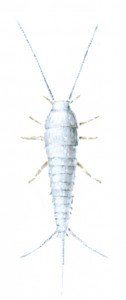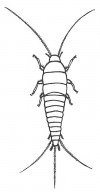

Latin: Lepisma saccharina
Silverfish are silvery glistening and can be up to 1 cm long. Silverfish hide in cracks and crevices during daylight. They are common in basements and attics, where they can be found in birds’ nests and old, abandoned wasps’ nests. Silverfish is practically omnivorous, with a preference for starchy foods. Their protein demands are covered largely by eating dead insects. They are somewhat able to digest cellulose, but they also graze on the mould that grows on damp paper. Each female lays up to 100 eggs, which are located individually in cracks and crevices. At 22 ° C the eggs hatch in just over 40 days. The tiny silverfish offspring is similar to the adults, except in size. At 27 ° C, silverfish grow up and mature in 3-4 months. Silverfish thrive at temperatures between 25 and 30 ° C. At temperatures below 15 ° C development stops. Silverfish can get quite old, up to 4 – 5 years.
Silverfish do not survive if the relative humidity, where they live, drops to below 75% RH. Silverfish are not a serious food pest, but since silverfish also seek food elsewhere, there is a risk for transfer of bacteria and other germs. A drying-out of the premises will usually clear the problem. In places where silverfish are not tolerated, dusting or spraying with insecticides is as a reasonable measure. Here you have to concentrate on the animals’ habitats and sweep lists, loose tiles, pipe penetrations, etc.




